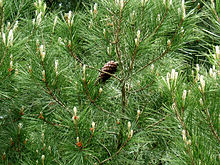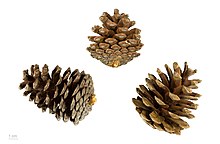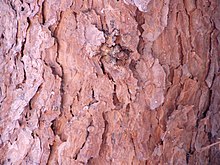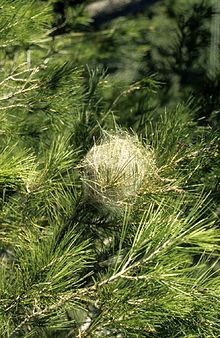Aleppo pine
| Aleppo pine | ||||||||||||
|---|---|---|---|---|---|---|---|---|---|---|---|---|

Aleppo pine ( Pinus halepensis ) |
||||||||||||
| Systematics | ||||||||||||
|
||||||||||||
| Scientific name | ||||||||||||
| Pinus halepensis | ||||||||||||
| Mill. |
The Aleppo pine ( Pinus halepensis ) is a two-needle plant species from the genus pine ( Pinus ) that is widespread in the Mediterranean region . The other German trivial name "See-Kiefer" is misleading because the closely related species Pinus pinaster is also called that.
description
Habitus
The Aleppo pine is a type of tree that usually reaches heights of 10 to 20 meters, rarely even 25 meters. The stands usually consist of crooked trees, but they also grow straight on optimal locations. The shape of the crown varies according to age and origin. Young Aleppo pines have a conical crown, later it becomes broad and storied. Plants from the high altitudes of Euboea and Elanis are narrow- crowned and finely knotted even in old age. Trees of this origin reach chest height diameters of 70 to 80 centimeters.
Needles
The needles stand in pairs on short shoots, are light green and between 7 and 15 centimeters long. They are 0.4 to 0.6 millimeters thick, 0.6 to 1.0 millimeters wide, and are straight to slightly twisted. There are 40 to 60 small teeth per centimeter on the edge. The needles remain on the tree for two years. In the needle cross-section, two marginal resin channels can be seen in young trees, 3 to 8 in old trees. The 3 needle sheaths are up to 6.2 millimeters long and last until the needles are shed.
Flowers, cones and seeds
Depending on the location, it blooms between March and April. The first female cones are sometimes already formed at the age of three, male flowers usually a year later. The male cones are green at the beginning and yellow at maturity. Female cones are purple at the beginning and red at flowering. At the beginning they stand upright on a 1 centimeter long stalk, after pollination they bend down.
The ripe cones are egg-shaped and 4.3 to 10 inches long. At the widest point, the diameter is 2.5 to 4.2 centimeters. The cones are straight or at most slightly curved. There are two or three people standing in groups, the handle is strong and curved downwards. The cone scales form a shiny, almost flat, rhombic and cross-keeled apophysis , which bears a clear umbilicus ( umbo ) without a thorn. Ripening takes place in the second year after pollination. The cones then open over a period of several years. Ripe cones are brown and often turn ash gray to dark gray with age. The germination power of the seeds remains high for 12 years and longer. After a forest fire or after the tree has been felled, the cones open quickly and thus enable rejuvenation.
The seeds are mottled light to dark gray, 5.8 millimeters long and 1.5 to 3.8 millimeters thick. They have a wing that is 1.6 to 3.2 inches long. The thousand grain mass is 13 to 22 grams, depending on its origin. The germination rate of around 90% is not increased by fire, the species is not a real pyrophyte , but often colonizes fire areas.
The seedlings have 7 to 8 cotyledons around 2.5 cm long. In the first year they reach 30 centimeters in height and during this time only form primary needles that are bluish green and around 2.2 centimeters long.
Chromosome number
The number of chromosomes is 2n = 24.
Root system
The trees form tap roots . Main and strong lateral roots penetrate deep and well-drained soils at depths of up to 3 meters. Long and strong side roots are formed on shallow sites that anchor the tree. Common ectomycorrhizal -Partner are Tonblasse Fälbling ( Hebeloma crustuliniforme ), the milk cap ( Lactarius deliciosus ), the Violette Rötelritterling ( Lepista nuda ), the Zitronenblättrige Täubling ( Russula sardonia ), the Suillus bovinus ( Suillus bovinus ), Pisolithus tinctorius , Thelephora terrestris and Tricholoma albobrunneum . These mycorrhizal partnerships ensure the survival of the species in dry and nutrient-poor locations along the Mediterranean coast.
bark
The bark shows differences specific to its origin. In Eastern Europe the bark is cracked, rough and dark brown; in North Africa smooth and light brown to white; scaly in Morocco; and in Western Europe smooth to cracked. Young shoots initially have a brown-green, later an ash-gray bark .
Wood
The wood is rich in resin and of medium quality. The reddish-brown heartwood is surrounded by a yellowish-white sapwood . Numerous resin channels can be seen in the cross section. Due to the high resin content, it can only be processed moderately well.
| Mechanical properties | value | unit |
|---|---|---|
| Density (r 0 ) | 0.71 | g / cm³ |
| Bulk density (r 12 ) | 0.75 | g / cm³ |
| Compressive strength (axial) | 55 | N / mm² |
| Flexural strength | 119 | N / mm² |
| Shrinkage , volume | 12.2 | % |
Distribution and location


The Aleppo pine is tied to the Mediterranean region and planted around 3 million hectares of natural forests. In North Africa it grows from Morocco to Libya in the Sahara Atlas at altitudes of up to 2,200 meters. In the north it occurs from eastern Spain through southern France , Italy and the Adriatic coast of the Balkan Peninsula to the Ionian Islands . In Greece it reaches the eastern limit of its European distribution, in the Peloponnese it rises up to 1,000 meters, in Chalkidiki up to 650 m. In the eastern Mediterranean region, it occurs from Israel via Jordan to Turkey . There are some isolated populations in Lebanon , Syria and southern Turkey in the middle of the area of the Calabrian pine ( Pinus brutia ). Stocks on Corsica , Rhodes and Southeast Turkey are interpreted as artificial plantings. It is missing from most Central European collections, as it can only survive in a few places north of the Alps that are protected from the severe cold.
The climate in the area ranges from semi-arid to Mediterranean to subhumid and humid . The annual precipitation ranges from 300 to 1,000 mm, the extreme temperatures range from +50 ° C to −18.6 ° C. The species is sensitive to late frosts. It occurs mainly over limestone , but also thrives over slate , serpentine and gneiss . The pH optimum is between 6 and 7.5, the limit ranges at pH 5 and 8.6. It does not grow on salt soils, but it can withstand seawater spray.
The Aleppo pine usually grows in mixed stands with different oak species, but also other pine trees such as the Calabrian pine ( Pinus brutia ), the black pine ( Pinus nigra ), the maritime pine ( Pinus pinaster ), the pine ( Pinus pinea ) and other conifers such as the Greek fir ( Abies cephalonica ), the Spanish fir ( Abies pinsapo ), the Atlas cedar ( Cedrus atlantica ), the stinging juniper ( Juniperus oxycedrus ) and the Phoenician juniper ( Juniperus phoenicea ). Especially in Greek forests it often comes together with the eastern strawberry tree ( Arbutus andrachne ), the western strawberry tree ( Arbutus unedo ), the hairy thorny gorse ( Calicotome villosa ), Carpinus duinensis , various rock roses ( Cistus ), the tree heather ( Erica arborea ), Erica verticillata , the manna ash ( Fraxinus ornus ), the thorny gorse ( Genista acanthoclada ), the olive tree ( Olea europaea ), the mastic bush ( Pistacia lentiscus ), the turpentine pistachio ( Pistacia terebinthus ), the broad-leaved stone linden ( Phillyrea latifolia ) , the thorny Bibernelle ( Poterium spinosum ), the Kermes oak ( Quercus coccifera ), the holm oak ( Quercus ilex ), and the downy oak ( Quercus pubescens ). Under favorable conditions, the undergrowth can become so dense that it endangers the natural regeneration of the Aleppo pine.
Frequent mix-ups
In the media (television, illustrated books, Internet) the pine (Latin: Pinus pinea , English: Stone Pine ) is often confused with the Aleppo pine (Latin: Pinus halepensis , English: Aleppo Pine ), which dominates the Mediterranean region . It is rather a rare exception that a pine tree can actually be seen when people talk about a pine tree. The cause is almost always the wrong translation from the English language (English pine is translated as "pine" instead of "pine", as it should be). At the location, the Aleppo pine can easily be confused with the maritime pine ( Pinus pinaster ), but it can be distinguished from it by the stalked cones.
Diseases and pests
Three types of mushrooms are named that are particularly important at regional level. The common honey fungus ( Armillaria mellea ) causes great damage , especially on the island of Evia . It penetrates through the roots and causes the trees to die. This species is mainly found in mixed stands with oaks, less often in pure stands. The ocher-yellow flour cup ( Cenangium ferruginosum ) infects the needles and causes them to turn yellow. It can spread to the twig bark and cause necrosis and resin leakage. If this species attacks the trunk, the crown parts above die off. It forms apothecia on the infected bark. The species occurs mainly in young populations, where it can occur epidemically every 1 to 3 years. The pine fire sponge ( Phellinus pini ) occurs mainly in the vicinity of Athens , Thessaloniki and Kassandra . It colonizes and decomposes the heartwood of living trees, making them more susceptible to windthrow . The nematode species Bursaphelenchus sexdentata causes a wilt disease. The baker's goat ( Monochamus galloprovincialis ) eats the needles and gnaws young twigs that often die. 1- to 3-year-old shoots are hollowed out by the great forest gardener ( Tomicus piniperda ) and later break off. Larvae of the bark beetle Orthotomicus erosus eat passages in the bark of the host trees. A very common pest is the pine processionary moth ( Traumatocampa pityocampa ), whose caterpillars eat the needles of young trees and overwinter in nests.
use
The Aleppo pine is an important forest tree in the Mediterranean region and is used in a variety of ways. The wood is of medium quality and is processed into construction timber, chipboard , barrels and furniture. It is also used as pit and firewood. In some areas of North Africa it is an important source of energy. Due to its durability, it is also used in shipbuilding.
Resin extraction played a major role until a few decades ago, but is no longer of economic importance today. The resin of the Aleppo pine is added to the Retsina wine.
In Tunisia, the seeds are used to make a dessert that is made for the birthday of the Prophet Mohammed .
Systematics
The Aleppo pine is placed within the genus Pinus in the sub-genus Pinus , section Pinus and subsection Pinaster . Due to the large distribution area, there is a great intraspecific variation. The Calabrian pine ( Pinus brutia ), which used to be a subspecies of the Aleppo pine, is now regarded as an independent species and is the sister taxon to the Aleppo pine.
Natural hybrids between these two species occur in the region around Grado in Italy and on the Greek peninsula of Chalkidiki . In artificial crossing attempts it turned out that a crossing only succeeds if the Calabrian pine acts as the mother tree.
literature
- Schütt, Weisgerber, Schuck, Lang, Stimm, Roloff: Lexicon of Conifers . Nikol, Hamburg 2008, ISBN 3-933203-80-5 , p. 393-402 .
Web links
- Botanical information about the type of conifers.org (Engl.)
- Distribution map
- Pinus halepensis in the endangered Red List species the IUCN 2006. Posted by: Conifer Specialist Group, 1998. Retrieved on 12 May, 2006.
Individual evidence
- ↑ German name after Robert Zander : Zander. Concise dictionary of plant names. Edited by Walter Erhardt , Erich Götz, Nils Bödeker, Siegmund Seybold . 18th edition. Eugen Ulmer, Stuttgart 2008, ISBN 978-3-8001-5408-1 , p. 638.
- ^ Tropicos. [1]
- ↑ David S. Gernandt, Gretel Geada López, Sol Ortiz García, Aaron Liston: Phylogeny and classification of Pinus . Taxon, Volume 54, 2005, pp. 29–42 (pdf; 452 kB) ( Memento from August 24, 2007 in the Internet Archive )






